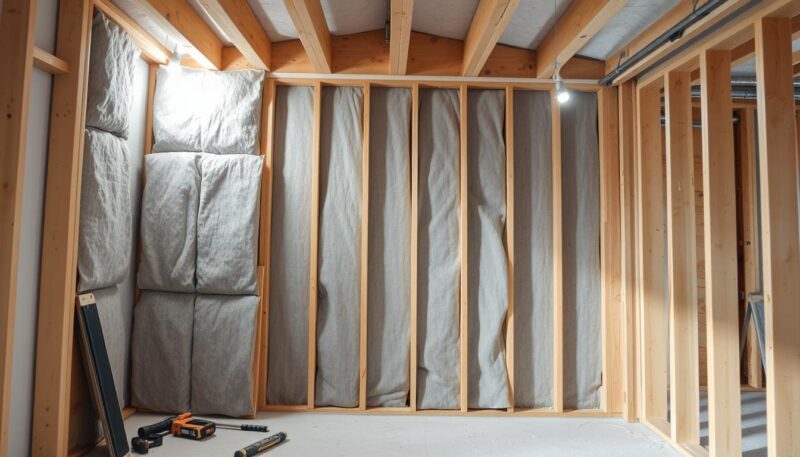Before diving into insulating interior walls, it’s essential to consider a few critical aspects to ensure a smooth and successful project. First, evaluate your home’s current HVAC efficiency and floor plan. In many cases, enhancing the heating and cooling system or improving exterior wall insulation may provide more substantial benefits than insulating interior walls. However, there are specific scenarios—such as noise control and moisture protection—where interior wall insulation can make a marked difference.
Most interior walls don’t require insulation unless for particular advantages such as noise dampening or protecting against moisture. It’s crucial to consult with professionals, like those at One Hour Heating & Air Conditioning, before beginning your project to examine whether insulating interior walls is the right move for your home.
Understanding building codes and standards is another vital consideration. Building codes may dictate certain requirements for wall preparation and insulation types. For instance, insulation’s R-value—a measure of its resistance to heat flow—is fundamental in choosing the right material. Higher R-values indicate better thermal performance, which can directly impact your home’s energy efficiency.
The tools and materials you’ll need for installing insulation vary but typically include a staple gun, tape measure, utility knife, work gloves, shop vacuum, and safety equipment like a tight-fitting breathing protection and safety goggles. If you’re tackling the project as a DIY vs. professional installation, make sure you are adequately prepared and follow safety guidelines.
Additionally, wall preparation is necessary before adding insulation. Ensure the wall cavities are free from debris and moisture. Depending on your home’s age and construction, you might need to address other issues like wiring or plumbing that intersect with the walls being insulated. Paying attention to these details can help avoid costly problems down the line.
Keep in mind that insulation materials usually come in 8-foot lengths, suitable for standard ceiling heights. Studs, the vertical framing members in your wall, are typically spaced 16 or 24 inches apart. This spacing impacts the choice of insulation width and the amount you’ll need to order. Also, bear in mind that some insulation comes with face coverings like Kraft paper or fire-retardant foil, which serve as vapor barriers to prevent moisture migration into wall cavities.
If your home falls within certain locations in the United States, the Department of Energy provides zone maps to help you determine the minimum R-values for insulation based on your region and heating system. Using these resources can guide you in making the most cost-effective choices for your insulation project.
Balancing cost and efficiency is also a significant factor. Interior wall insulation often proves to be a more budget-friendly option compared to exterior insulation. The total cost of an internal wall insulation project usually involves about two-thirds for the materials and one-third for professional labor. The type of insulation you choose—be it batts, rolls, or spray foam—will also affect the overall cost.
Overall, insulating interior walls can enhance your home’s energy efficiency, noise control, and moisture protection. With thoughtful planning and consideration, you can achieve excellent results, whether you opt for DIY or professional installation. Take the time to assess your specific needs and consult with experts to make informed decisions, and you’ll be well on your way to a more comfortable and efficient home.
Benefits of Insulating Interior Walls
Insulating your interior walls might not be as essential for energy savings as exterior wall insulation, but it still offers numerous advantages. From enhancing energy efficiency to improving soundproofing options and providing moisture protection, interior wall insulation proves to be a valuable investment.
Energy Efficiency
While exterior wall insulation generally has a more significant impact, insulating the right interior walls can help regulate temperatures between rooms and floors. This can lead to consistent room temperatures and a reduction in energy costs over time. In homes with zones used seasonally, this regulation becomes even more crucial, helping you achieve better overall energy efficiency.
Noise Control
One of the major benefits of insulation for interior walls is soundproofing. Effective soundproofing options can create a quieter environment, which is particularly beneficial for homes with multiple residents or remote workers. Insulating materials like mineral wool or loose-fill are excellent choices for reducing noise transmission between rooms.
Moisture Protection
Moisture protection is another significant benefit of insulating interior walls. In rooms prone to moisture, such as bathrooms and kitchens, proper insulation can prevent condensation and mitigate risks like mold and mildew. This not only preserves the integrity of your home but also ensures the comfort and health of your living spaces. Vapor control layers play a vital role in mixed-humid and cold climates, adding an extra layer of protection.
Overall, whether you aim to improve energy efficiency, enhance soundproofing, or provide moisture protection, the benefits of insulation make it a worthwhile consideration for your home.
Types of Insulation for Interior Walls
Choosing the right type of insulation for your interior walls can significantly impact your home’s energy efficiency, noise control, and moisture protection. With various insulation materials available, you can select the one that best fits your specific needs and budget. Let’s delve into the primary types of insulation for interior walls: Loose-Fill Insulation, Rigid Form Board, and Spray Foam Insulation.
Loose-Fill Insulation
Loose-Fill Insulation, available in materials such as cellulose, fiberglass, and mineral wool, is a versatile option for both enclosed existing wall cavities and open new wall designs. This type of insulation is installed using a blower machine, which propels the material through small holes drilled into the wall. As a minimally invasive installation method, it is ideal for retrofitting existing homes. With R-values ranging from R-2.2 to R-3.8, Loose-Fill Insulation provides effective thermal performance while also being cost-efficient. It’s an excellent choice for adding insulation to attic floors and other hard-to-reach spots.
Rigid Form Board
Rigid Form Board, or foam board insulation, is a robust and durable insulation material typically made from polystyrene, polyisocyanurate, or polyurethane. This type of insulation is commonly used in new constructions or major renovations, providing high insulating value with relatively little thickness. Ideal for unfinished walls, foundation walls, and floors, Rigid Form Board boasts R-values ranging from R-4 to R-6.5 per inch of thickness. While the installation process can be more labor-intensive and expensive compared to other types, the long-term benefits of exceptional thermal resistance make it a worthwhile investment.
Spray Foam Insulation
Spray Foam Insulation stands out for its capacity to create an airtight seal, effectively preventing air leaks. This insulation type is applied directly to the surface of a wall, where it expands to fill any cavities or gaps. Depending on the formulation, Spray Foam Insulation can achieve R-values between R-4 to R-6.5 per inch, with open-cell variants providing R-3.7 per inch and closed-cell options reaching up to R-6.2 per inch. Applied using either small spray containers or pressure-sprayed products, Spray Foam is often preferred for irregularly shaped spaces and around obstructions. While the initial cost might be higher, the superior insulating properties and air barrier performance offer substantial energy savings over time.

